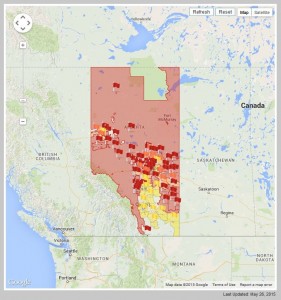Brandi Morin
APTN National News
Dozens of out of control wildfires have forced the mandatory evacuation of more than 3,000 people from their homes in northern Alberta.
The Bigstone Cree Nation (BCN) located near Lake Wabasca 320 kilometres north of Edmonton stated in a release Tuesday that the fire was started by a burning vehicle last Saturday on the reserve transfer site.
Alberta Environment and Sustainable Resource Development ordered the evacuation of the BCN and Wabasca starting last Sunday.
The Municipal District of Opportunity established reception centers for all evacuees in the Hamlet of Calling Lake and the County of Athabasca.
“The MD and Bigstone Cree Nation are very grateful for offers of assistance from the public and outside agencies,” read the statement.
“At this time, the evacuees are supplied with necessities and the Wabasca and BCN Fire Department are well supplied with equipment and manpower. Provincial agencies and an animal welfare agency are also on scene.”
The RCMP has approximately 50 members on scene to secure the community.
BCN resident Nicole Auger fled the community with four members of her family, including her sister who is pregnant and her aunt who has liver and kidney issues.
At the time they left, the Red Cross was not yet set up in nearby evacuation sites to accommodate their needs.
The BCN sent them to stay at a hotel in Edmonton.
“It’s all very tiring and surreal,” she said of suddenly packing up and leaving home.
Augers father stayed behind, and told her over the phone that the smoke in Wabasca is not very prevalent yet.
“He’s kind of being stubborn and won’t leave. But he said you can’t see the fire. ” she said.
According to the release from the province of Alberta, a total of 3,750 Wabasca hamlet and reserve residents are registered as evacuees.
Last night 630 people were housed in reception centres in Calling Lake and Athabasca and another 400 people are either camping in Calling Lake or staying with family and friends there. Approximately 100 people with special needs are being lodged in hotels as far away as Westlock.
On Tuesday the Friendship Centre in Slave Lake, home to the 2011 tragic fires that wiped out over a 1/3 of the town, opened its doors to evacuees.
Alberta Government wildfire information officer, Geoffery Driscoll said that wildfires are a natural part of Alberta’s landscape and something that happens all the time.
On average the province sees about 1,500 wildfires a year and the north is no stranger to them.
The main cause of wildfires are from lightning and overly dry conditions.
“We can’t do much about the fires that we’re going to have to fight, there’s no choice there,” said Driscoll.
However, it’s the human caused fires that could be prevented that end up causing an extra burden for firefighters.
On Monday the government enacted a province wide open-fire ban. This type of ban was last implemented in 2011 during the disastrous Slave Lake fire.
About 40 fighters as well as helicopters, air tankers and heavy equipment are working around the clock to contain the fire near Wabasca.
“The fire that’s near Wabasca and the Bigstone Cree Nation hasn’t grown much in the past day thanks in part to the work of firefighters in that area. They’ve been able to get in front of it and put a fire guard around most of that fire. It’s still considered out of control, but we’re going to see what happens in the warmth of the day and see if the firefighters can continue to contain that fire,” said Driscoll.
There are currently about 60 fires burning across Alberta, 50 of which were started just last night by lightning, 19 of them are listed as out of control.
Today the Alberta government’s provincial operations center in Edmonton opened in response to the out of control wildfires.










